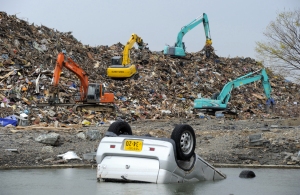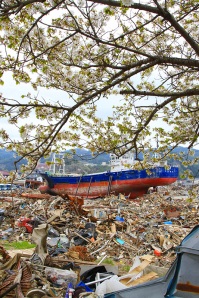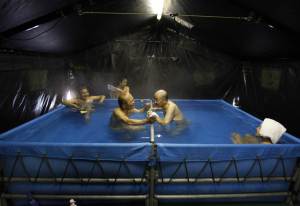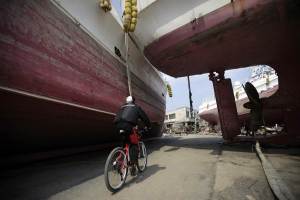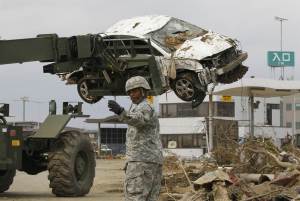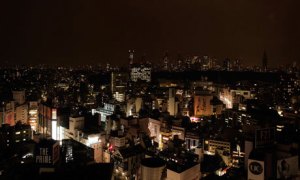“Look, Grandpa! All these nice young people have come to help us out! Aren’t we lucky?” The farmer’s wife attempted to coax a smile
from her stolid husband as eleven young Peaceboat volunteers, armed with pickaxes, shovels, hoes and wheelbarrows, removed stone after stone from the old man’s garden….or what had been his garden before the 3-11 tsunami washed over the area, transforming the land into a literal bed of rocks.
In Miyagi Prefecture’s Ishinomaki City, rubble from buildings and cars was washed inland, while land closer to the seaside was inundated with stones. Removing the stones from a single farmer’s plot of land took the Peaceboat volunteers a day and a half. My daughter Ellen (who has asked me to write about her week’s volunteer experience) and the rest of the crew were relieved that they were able to take a bath that evening at the local public bath house, or Sento. “No-one drank sake in the evenings or stayed up late partying,” she said. “It was lights out by ten, and we went right to sleep, exhausted.” This is exactly what every mother wants to hear, and I approved heartily.
Returning to the story of the farmer and his rocky plot, a truck arrived from Ishinomaki City on the second day, laden with eight tons of fresh soil from the mountainside and fertilizer as well. The Peaceboat Rock Removal Team called it quits at that point, morphing into the Cultivation Team. The farmer, assisted by the volunteers, tilled the soil that very afternoon, mixing the saline tsunami-ravaged soil, the fresh soil from the mountainside, and the fertilizer (provided by Ishinomaki City for a nominal fee). The result was a relatively-rock-free garden plot, ready for planting. His wife could not wait to get the first crop of potatoes in the ground, and began the process straightaway.
The finishing touches of the rock removal, the soil cultivation, and the planting were all accomplished in a single day, thanks to the communal efforts of volunteers, city officials, and the farmer himself. While other Ishinomaki residents are still marking time in temporary housing, this man and his wife did indeed get lucky. My daughter got a deep tan, some muscles in her slim arms, and an education.
Removing the debris from Ishinomaki has been a long and painful process. Thanks to the
efforts of Japan’s self-defense forces and international as well as local volunteer efforts, the worst has been dealt with; for the most part, rubble has been cleared from residential areas. It is now piled in neat and tidy mountains, visible from the highway. The images are jaw-dropping, and the problem of disposal of the contents of these mountains is the hottest topic on the nightly news. It is also a separate blog entry altogether, and I do not intend to go there right now. Instead, I will focus on what my daughter saw and learned during her week in Tohoku (this past April), exactly as she reported the situation to me. Though I am known to exaggerate (just a wee bit) in daily conversation, I vow not to stray from the story line or add my own embellishments. In fact, if I do her stories justice, the embellishments will not be needed or missed.
Now that the worst of the rubble has been cleared, Peaceboat volunteers are focused on the families (mostly elderly couples) who have chosen to stay in the tsunami-ravaged towns, helping them rebuild their lives and regain a measure of independence. In short, helping to restore hope. The soil restoration projects began when a Peaceboat organizer sounded out some residents of a local temporary housing complex: “Any farmers here who want to get back to work? Need some help getting started?” “Absolutely!” was an elderly farmer’s response, and the Peaceboat volunteers began the process of recreating workable garden plots, one at a time.
Before reviving Oyama-san’s rocky garden plot, the Peaceboat volunteers also assisted a farmer living farther inland. This man’s land was a veritable treasure-trove of rubble, and involved another full day of work by fifteen volunteers. Again, using pickaxes and shovels, here’s a partial list of what the volunteers found buried in the soil: credit cards. Old tires. Remote controls. Washlet toilet knobs and parts. Batteries. Eyeshadow in case, still usable. Bra and panties. Plastic bag stuffed full of ¥100 coins (this is called “heso-kuri”, or money squirrelled away). And much more, including the all-pervasive rocks. While the workers dug and sorted, another farmer strolled by to watch the process. “Oi! Come over and do my yard, too!” he called. After a sizable pile of rubble had been collected, the sorting began: burnable items, non-burnable items, and rocks. Toward the end, my daughter admits, everyone was so tired that they became adept at making split-second decisions, and tossing items swiftly into what they hoped was the appropriate pile. The Peaceboat crew were not able to stay around to see the farmer and his wife turn their newly-cleared land into an actual garden, but the couple thanked the volunteers profusely before they left, and insisted that they keep the bag of ¥100 coins.
After days of digging, the Peaceboat team relocated to an area known as “Same no Ura”, or Shark Bay. Here a city official in charge of working with volunteers gave a brief history of the area’s post-tsunami recovery efforts. The tsunami, he told the group, had left fishermen bereft of family members, homes, boats, fishing equipment, and hope. Local officials had urged the remaining residents to persevere (“ganbaru”) and attempt to rebuild their lives, but their words met with little or no enthusiasm. Living amidst the wreckage, fishermen saw no way up and out of the abyss, and no longer cared whether the fishing industry revived or not. Adding to this, they were bitter about the fact that volunteer efforts had begun inland, in residential areas, while those living in areas along the shoreline received less practical assistance in the first weeks after the disaster. And so, in late May and June of 2011 when Peaceboat volunteers approached the fishermen with offers of help, they were initially rejected. “What can you do to help us anyway? Our problems are too great, and your offer comes too late!” was the basic response.
Happily, the volunteers refused to take no for an answer, and began working, “katte ni”, or without being asked or welcomed. They began by sorting through a mountain of rubble near the ocean which appeared to contain many pieces of valuable fishing equipment, such as buoys and fish barrels. After the Peaceboat workers had recovered 100 barrels (with a monetary worth of approximately ¥15,000 or $150 apiece), they approached the fishermen again, appealing to their sense of economy and conservation. “Look what we found for you! And think of how much money it represents! If you’re not going to use these, we’re throwing them all out! So, what will it be?” The fishermen grudgingly admitted that they’d hate to see such an awful waste, and began considering the possibility of working again. Sharing the few available boats they had, they returned to the sea and began fishing–on a much smaller scale, but with hope for the future and a return of perseverance and determination to carry on.
As a postscript: September of 2011 brought a nasty typhoon that rampaged across a good part of the country, hitting Tohoku as well. Fishermen from Shark Bay again lost boats, equipment, and even cars. After the typhoon, Peaceboat staff hurried to check on the men

A Sea Squirt ; It’s a delicacy, I promise (Hah! You wouldn’t catch me even considering this knobby little rascal as food).
and offer encouragement…..only to find them in good spirits, even jovial. “Whaaat?! You think a little storm like that is going to keep us down after we’ve weathered the big one?? Hah!” They were still in good spirits last week, when my daughter and the rest of thevolunteers returned to help them construct underwater shell “beds” for sea squirts. Oyster shells, it seems, are the perfect home for sea squirt eggs, which attach themselves to the rough surface of the shells, remaining there for a full four years until hatching into strange-looking but reportedly delicious sea creatures. The Peaceboat team’s job was to finish up sorting the shells, drill holes in them and string them together in bunches, ready to
be tossed into the ocean by the fishermen. “The shell sorting alone had been going on for two months,” said my daughter. “We just did the tail end of the work.” To put this amount of work into perspective, the 20 or so volunteers sorted approximately 10 tons of shells per day, and the shell pile you see in the photo was more like “a pasture of shells”(said Ellen) to begin with.
With the shell beds finished and ready for use, the fishermen were in a fine mood, showing off their day’s catches for the volunteers, who took photos like crazy. To celebrate, sea urchins were served up as snacks, and eaten raw (“How?” I asked. “We cut them in half, and scooped out the inside with spoons,” said my daughter. “The sea urchin itself is a natural cup!” ) Most considered this a fine reward for the day’s work, and some even indulged in seconds.
Along with volunteer work, the Peaceboat team visited another region along the coast of Ishinomaki, known as Sakana Machi (or “Fish Town”). Here they viewed the surreal sight
of a massive (the size of a small house) metal can with a label reading “Whale Meat Sauce”, upended and left as a memorial in the middle of the once-thriving neighborhood. The can is bordered by highways on either side, and flowers have been planted alongside it. Whatever you may think of whale meat, or of whaling as an industry, there are still tsunami recovery stories to be told, and this is one of them.
The story goes like this: Fish Town, as its name suggests, was built around the fishing industry, and the canned whale meat factory was just one of many fish processing plants (approximately 200 in all) that suffered irreparable damage from the tsunami. The remains of the structure were covered in foul-smelling sludge, and millions of cans of whale meat–preserved in sauce–were buried in the muck and rubble. The factory shut down, workers were let go, and that seemed to be the end of things……until volunteers stepped in to literally pick up the pieces. The work of salvaging and washing undamaged cans took several months, but volunteers successfully recovered and sold enough cans to rebuild the factory and re-hire its former workers. The new factory is up and running, and the upended giant can remains, as a memorial to what was lost and what has been accomplished. Everything was accomplished bit by bit, with patience and perseverance, which seems to be the lesson to be learned here.
In short, my daughter’s week in Ishinomaki was about long days spent digging stones, sorting rubble into piles and boring holes in oyster shells. Hard work, nothing glamorous, and no beer in the evening as a reward. Volunteers were able to bathe twice that week, and slept on sleeping bags on the floor of an empty factory. Breakfast was a sandwich and coffee from the local convenience store, and fresh vegetables were a luxury. This is, as Japanese say, “atari-mae” (reasonable to the point of being obvious), as volunteers should not be eating up the resources of the folks they are assisting. Those who cannot live without daily comforts do not volunteer for Peaceboat, and the volunteers themselves are not all youngsters like my daughter (she’s 18, and a young-looking 18 at that). At any rate, you’ve got to respect all the volunteers–regardless of age–for their determination and self-discipline. I imagine that whiners are few and far between in the ranks, or work would not continue to progress and few would remain motivated enough to return after their first trial stint. “I have no idea why I did not do this earlier!” my daughter declared on her return home, a testimony to the satisfaction that comes from the combination of hard work and good camaraderie.
Readers of this blog may wonder about the “issues”: What about the level of radioactivity in the ocean? Were those raw sea urchins really safe to eat? And should Sakana no Machi be rebuilt at all–shouldn’t the whole area be relocated to higher ground? Why doesn’t the whaling industry take a big hint from the tsunami devastation and attempt to re-invent itself in a timely fashion (actually, one town is already considering this, in the form of a Whale Zoo, where tourists can swim with small whales and dolphins)? Why don’t folks still living in those dangerous coastal areas run for their lives already? And what about those mountains of rubble seen along the highways that are scheduled to be distributed to various prefectures country-wide for incineration? Aren’t families as far away as the US coastal state of Oregon concerned about the potential health effects of this already-done-deal??
Well, that’s exactly what I don’t want to plunge headlong into. Read the blog of EX- SKF, who makes it his business to stay on top of each and every issue, translating from Japanese to English with competence and coolness. Scrolling down the comments section of each post, you’ll get a sampling of the way his readers feel about the state of affairs in post-3-11 Japan. Let’s just say that it’s emotionally charged.
This post, on the other hand, is meant as something simpler. It’s a testimony from someone
who went to Tohoku (with few preconceived notions or opinions ), worked hard, and listened intently to those around her. What impressed her was the vastness of the area compared to the dearth of people, especially young people. “I didn’t see any residents under the age of forty all week!” my daughter proclaimed sadly on her return. However, the vigor and cheerfulness of the Ishinomaki ladies (hard at work making accessories from the stones and shells brought by the tsunami) and the determination of the older farmers and fishermen she met made an equally strong impression. It is much easier to be vigorous, cheerful, and determined when you’ve achieved a measure of independence and (therefore) dignity; this is exactly what stable and well-organized NPOs like Peaceboat are able to provide for the remaining residents of this coastal city.
Long-term Peaceboat volunteers stay in touch with those who continue to live in their partially-damaged houses or in temporary housing, assessing their needs and concerns, and organizing projects to address specific challenges. Unlike government assistance, which often requires those in need to be proactive (come to the capital city of Sendai and fill out this 40 page claim form and we’ll consider your request), NPO assistance is based on the assessments of a mobile team, who go from place to place with eyes and ears open, ready to scope out the next potential project. Peaceboat is also bilingual, accepting volunteers from other cultures, and working with translators to make sure that work goes smoothly. (Technically, my daughter could have done this job, but she admitted to being greatly relieved that an older, more confident and outgoing woman took care of all translation jobs within her team. )
In short, Prime Minister Noda and his cohorts in Tokyo could learn a lot from the organization and spirit of Japan’s NPOs. Fewer words, more action. Less waste, more conservation. Direct assessment of needs, smooth communication, and healthy doses of self-denial, hard work, and sweat. Nice going, Peaceboat. A bunch of old folks in Ishinomaki know they’re not forgotten and have regained a measure of joy and dignity. And a mother in Hadano can feel good about sending her daughter off on the night bus to dig for stones along a desolate shoreline. It’s a given that her week’s work was just a drop in the bucket, but surely even the crankiest old geezer or the most cynical critic cannot doubt that every drop counts. Find out more about the good work of Peaceboat here, and do consider a generous donation, or even joining their ranks. Thank you again for reading, and for your continued interest in Japan.














